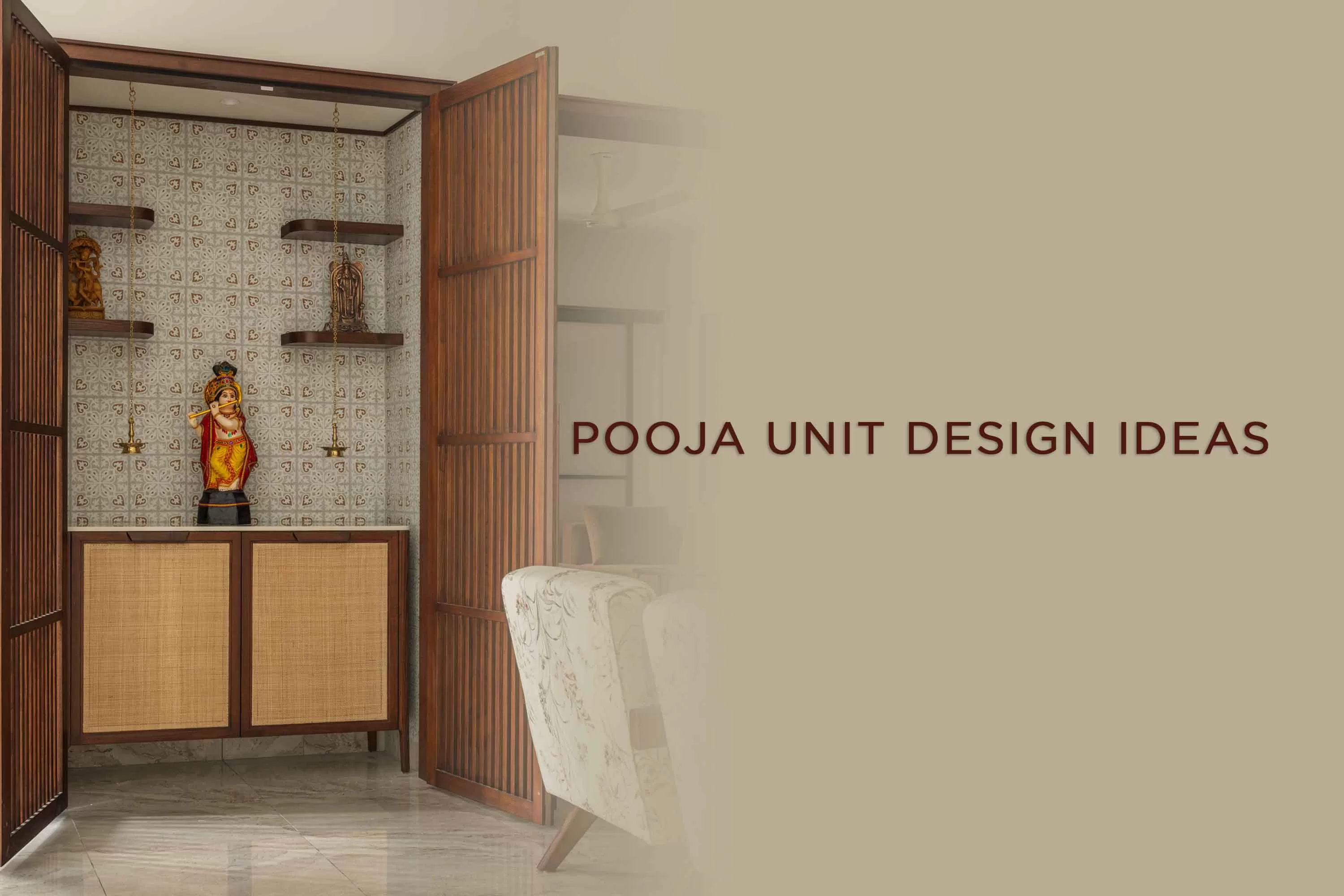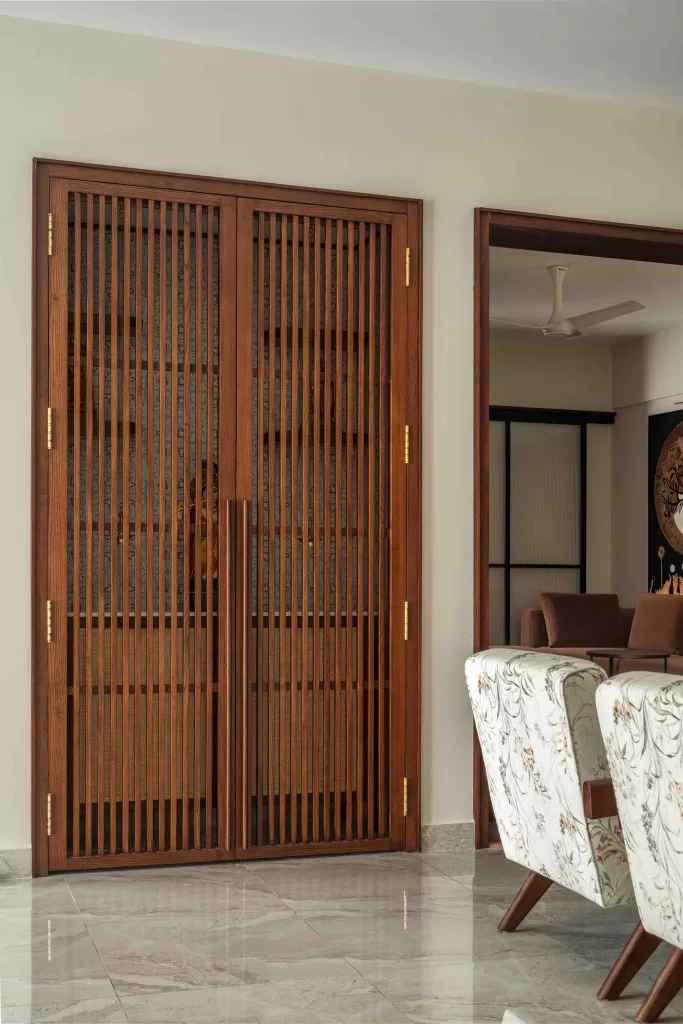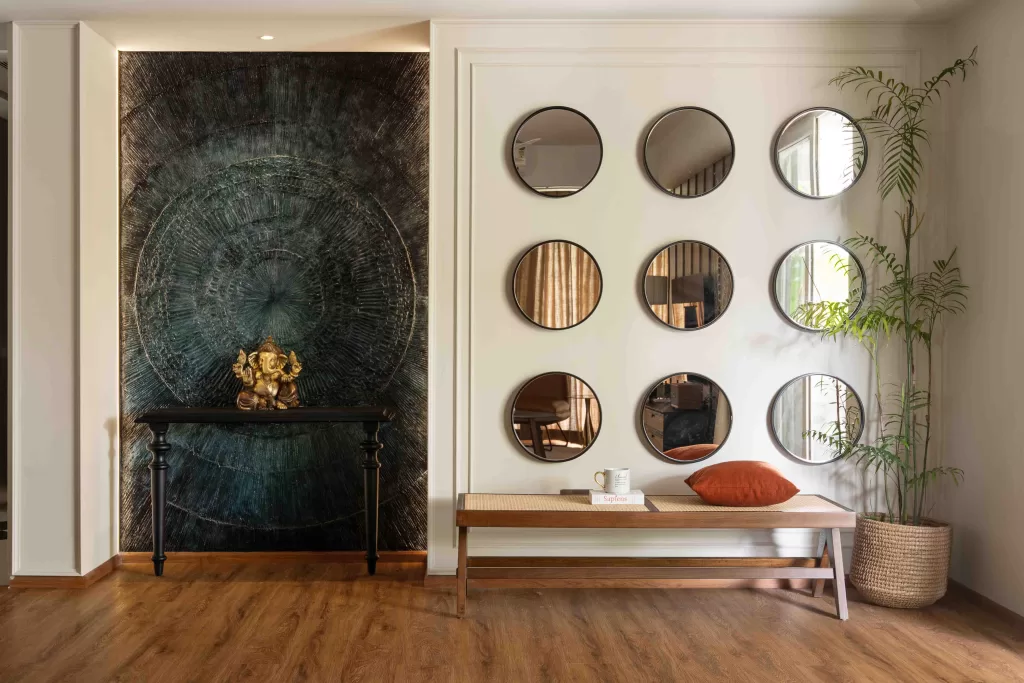The pooja room is the sacred heart of the home, where worship and meditation come together. According to Vastu Shastra, pooja room colors directly impact the vibrations, emotions, and energy flow in the pooja space. Choosing paint shades for a pooja room design is sometimes overlooked in terms of traditional design and paint shades.For many Indian households, a mandir is an essential part of the home. This pooja room design ideas allows for the continuation of cultural and religious practices in a contemporary setting. Designing the pooja room design with a traditional vibe is possible in modern living. Creating a proper and well-balanced pooja room design choice helps here
Saffron, a traditional color for pooja rooms, is known for its stimulating, happy, and bright qualities. It can also encourage determination and focus in homeowners as they follow their spiritual practices. Adding a wooden back panel and door frame would further enhance the room’s aesthetic appeal and serene atmosphere.
Folding doors
folding doors are the facade for pooja mandir. they are made with dark wood like teak as a vertical slatted details. this design allows air circulation when closed and offers a semi-transparent look. They provide privacy for the sacred space when needed and can be opened up for prayer.
bi-fold or multi-fold doors are more suitable rather than the traditional hinged doors.This mechanism allows multiple panels to fold against each other and stack neatly to one or both sides when opened, maximizing the opening width and minimizing the space occupied by the open doors. Given the depth of the mandir niche, they likely fold back into the wall or against the side panels.the grain of wood add natural texture and warmth.
Jali screens for partition
At its heart, jali is about perforation. These exquisitely carved wooden (or sometimes stone) screens create a interesting play of light and shadow. They offer a sense of privacy without sacrificing connection, and they’re a creative way to introduce a touch of traditional Indian aesthetics into even the most contemporary of homes. Think of it as a whispered suggestion of a wall, rather than a solid declaration.
The beauty of incorporating jali screens into your home is that it’s a very human-centered design choice. It acknowledges our need for connection but also our desire for a sense of personal space and reverence. It’s about crafting an environment that feels both expansive and intimate, where tradition meets contemporary living in a seamless, elegant dance. When you choose jali, you’re not just adding a partition; you’re inviting artistry, history, and a gentle, breathing beauty into your everyday life.
Material and Color Palette Inspiration for Latest Pooja Unit Designs
When considering the latest pooja unit designs, it’s all about balancing tradition with modern aesthetics and functionality. At the core of any pooja unit design are the materials, each contributing its own intrinsic color and character. Wood, ranging from classic to contemporary, remains a timeless choice. Inspired by the rich, dark wood , which instantly evokes warmth, tradition, and gravitas, traditional latest pooja unit designs often feature deep tones like Teak, Rosewood, or Walnut. These woods naturally offer deep browns, reddish-browns, and sometimes even subtle purplish undertones, pairing exquisitely with polished brass, antique copper, or deep gold accents for an opulent feel. Conversely, for a more modern aesthetic, the latest pooja unit designs frequently incorporate lighter wood tones such as Maple, Ash, or light Oak. These bring a sense of airiness and spaciousness, ideal for more compact living areas, with natural colors spanning creamy whites to pale yellows and light browns. For budget-friendly yet versatile options, high-quality laminates or engineered wood can beautifully mimic natural wood grains, providing an extensive palette including distressed finishes, grey washes, and exotic patterns.
- Lighting is arguably one of the most critical elements in defining the spiritual ambiance and aesthetic appeal of any pooja mandir unit, transforming it from a mere structure into a sacred sanctuary. Beyond mere illumination, it plays a pivotal role in creating a serene and inviting atmosphere, enhancing the intricate details of the pooja mandir unit and the deities within. When designing the lighting scheme, the choice between warm and cool tones significantly impacts the mood; warm white or soft yellow lights are typically favored as they evoke a traditional, inviting glow, reminiscent of traditional oil lamps and lending a timeless warmth to the space. Conversely, cooler white lighting can be employed in more contemporary, minimalist pooja mandir unit designs where a pristine, clean aesthetic is desired
By carefully considering factors like space, materials, color palettes, and lighting, you can transform any area into a sacred haven. Whether you envision a grand, traditional sanctuary or a minimalist modern niche, the journey of designing your pooja room design should be one of peace and inspiration. Ultimately, a well-executed pooja room design is more than just an architectural feature; it’s a reflection of faith, a tranquil corner for introspection, and a beautiful addition to any home. Let your pooja room design truly resonate with your spiritual journey and personal aesthetic.



